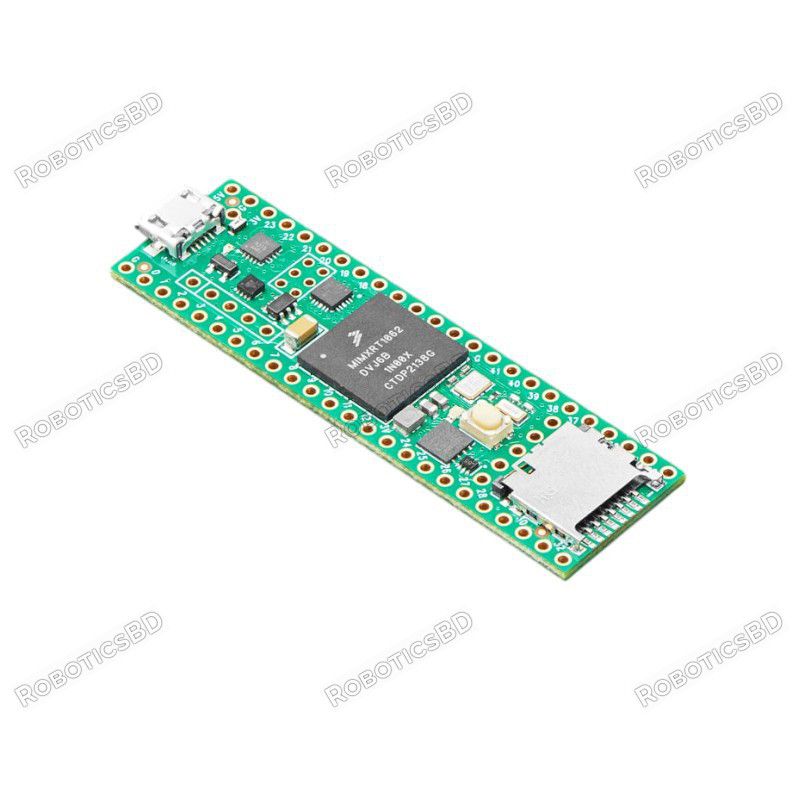
Reference: RBD-1354
Jumper Wire Single 20cm
Length: 8 inches/20 CM (Long) Material: Copper Plated Pin Spacing: 2.54mm.
Reference: RBD-1354
Length: 8 inches/20 CM (Long) Material: Copper Plated Pin Spacing: 2.54mm.
Reference: RBD-0351
Contactless transmission of data and supply energy (no battery needed) Operating distance: Up to 100mm (depending on antenna geometry) RoboticsBD Operating frequency: 13.56MHz Data transfer: 106 kbit/s Data integrity: 16 Bit CRC, parity, bit coding bit counting Anticollision Typical ticketing transaction: <100 ms ( including backup management)...
Reference: 0245
Choose your desire Resistor value from below:
Reference: 0031
3 Types Available (Please select from option) 1. Male to Male 2. Male to Female 3. Female-Female
Reference: RBD-0768
Size: 5mm Color: RED Head Shape: Round Lens Appearance: Transparent
Reference: 1353
Length: 12.5 inches/30 CM (Long) Material: Copper Plated Pin Spacing: 2.54mm.
Reference: RBD-0761
Breadboard friendly Mounting Style: Through Hole Mounting Direction: Vertical



Teensy 4.1 is the most powerful Arduino compatible microcontroller available today. Based on the NXP i.MX RT1062 ARM Cortex-M7 running at 600MHz with the ability to be overclocked. It is formatted into a very compact ‘teensy’ board outline for easy embedding into projects or for use with solderless breadboards. Perhaps best of all, it is compatible with the popular Arduino IDE programming environment as well as many of the existing Arduino libraries, so it is very easy to get up and running unlike many other advanced microcontrollers that are available.
 Store Pickup Available!
Store Pickup Available!
 Free Ship Over 5000 BDT
Free Ship Over 5000 BDT
 Quality Product
Quality Product
 No Warranty
No Warranty
 No Replacement
No Replacement
Teensy 4.1 is the most powerful Arduino compatible microcontroller available today. Based on the NXP i.MX RT1062 ARM Cortex-M7 running at 600MHz with the ability to be overclocked. It is formatted into a very compact ‘teensy’ board outline for easy embedding into projects or for use with solderless breadboards. Perhaps best of all, it is compatible with the popular Arduino IDE programming environment as well as many of the existing Arduino libraries, so it is very easy to get up and running unlike many other advanced microcontrollers that are available.
Besides the standard Teensy 4.1 available with and without standard pins, we are now carrying two other variations of the basic product:
Teensy 4.1 NE – Teensy 4.1 with No Ethernet (NE)
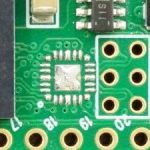
The Teensy 4.1 NE modules are exactly the same as the standard Teensy 4.1 except the NE version is missing the Ethernet PHY chip as shown here. This chip provides the interface between the Ethernet controller built into the NXP microprocessor and the physical Ethernet cable.
Some Teensy 4.1 are now being built without this chip due to on-going PHY chip shortages plus a price increase on the part. If you don’t plan to use wired Ethernet, the NE version is a good option to consider since it is a little less expensive than the standard version and otherwise identical.
All of our Fully Loaded Teensy 4.1 products have this chip and have Ethernet capability.
Teensy 4.1 Lockable – Teensy 4.1 that can be locked into a secure mode.
The lockable Teensy 4.1 is a special version which can be permanently locked into a secure mode. Secure mode implements encryption of the software and prevents unauthorized copying or cloning of the software. This version is identified with a lock symbol stamped on the CPU. Our lockable Teensy 4.1 all have Ethernet capability.
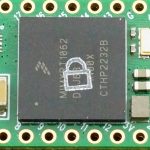 The lockable version will operate like a standard Teensy 4.1 if it is not locked, but it removes some of the safeguards that are built into the standard Teensy 4.1 to prevent permanently bricking the module with bad software. For this reason, it is recommended only when code security is a requirement, usually for commercial applications.
The lockable version will operate like a standard Teensy 4.1 if it is not locked, but it removes some of the safeguards that are built into the standard Teensy 4.1 to prevent permanently bricking the module with bad software. For this reason, it is recommended only when code security is a requirement, usually for commercial applications.
Our Teensy 4.1 Fully Loaded products with additional memory or Teensy 4.1 Audio Stacks can also be built with this lockable version of Teensy 4.1 upon request.
Refer to the PJRC page on Code Security and Lockable Teensy for more information on using this feature: https://www.pjrc.com/teensy/td_code_security.html
Teensy 4.1 Fully Loaded Products
If you are looking for Teensy 4.1 with the Ethernet header preinstalled and optionally PSRAM or Flash chips preinstalled and tested, head over to this page: Teensy 4.1 Fully Loaded
If you are looking for Teensy 4.1 built for use with a custom PCB like our Prototyping System for Teensy 4.1, header over to this page: Teensy4.1 Fully Loaded for Prototyping System
These Fully Loaded versions are also available for ordering near the bottom of this page.
The Teensy product line which is focused on being fast , small and Arduino compatible is developed by the company PJRC. They have a loyal following of designers and advanced hobbyists that create many libraries to take advantage of some of the more advanced features of the Teensy products or to modify Arduino libraries for compatibility. Many of them also participate in the excellent PJRC forum. The forum is targeted towards more advanced users and topics.
Just how fast is it? The chart below shows the Teensy 4.x series compared to some other popular boards using the CoreMark Benchmark test. Larger numbers = faster performance.
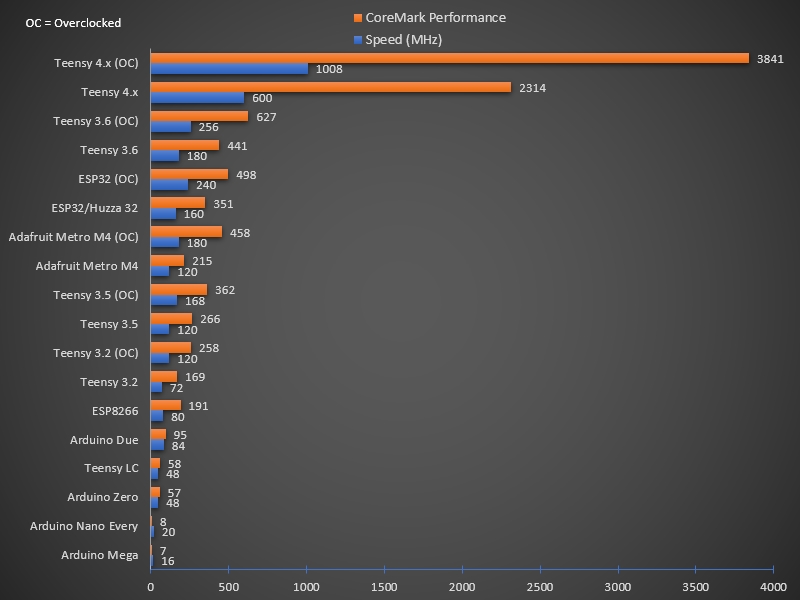
As another example, the classic Mandelbrot set was calculated and displayed using a Mega 2560 which took between 77 and 105 seconds per image. Calculating the image is very mathematically intensive. The Mega 2560 was then swapped out for the Teensy 4.1 and it took 1.24 to 1.26 seconds for the same task running the same software on both.
The heart of the i.MX RT1060 microcontroller is an ARM Cortex-M7 CPU core that brings many powerful features to a true real-time microcontroller platform.
The Cortex-M7 is a dual-issue superscaler processor, meaning the M7 can execute two instructions per clock cycle, at 600MHz! Of course, executing two simultaneously depends upon the compiler ordering instructions and registers. Initial benchmarks have shown C++ code compiled by Arduino IDE tends to achieve two instructions per cycle about 40% to 50% of the time while performing numerically intensive work using integers and pointers.
The Cortex-M7 is the first ARM microcontroller to use branch prediction. On the M4 as used on the Teensy 3.2, loops and other code which must branch take three clock cycles. With M7, after a loop has executed a few times, the branch prediction removes that overhead, allowing the branch instruction to run in only a single clock cycle.
Tightly Coupled Memory is a special feature which allows Cortex-M7 fast single cycle access to memory using a pair of 64 bit wide buses.
These extremely high speed buses are separate from M7’s main AXI bus, which accesses other memory and peripherals. 512K of memory can be accessed as tightly coupled memory.
Teensyduino automatically allocates your Arduino sketch code into ITCM and all non-malloc memory use is allocated to the fast DTCM, unless you add extra keywords to override the optimized default.
Memory not accessed on the tightly coupled buses is optimized for DMA access by peripherals. Because the bulk of M7’s memory access is done on the two tightly coupled buses, powerful DMA-based peripherals have excellent access to the non-TCM memory for highly efficient I/O.
Teensy 4.1’s Cortex-M7 processor includes a floating point unit (FPU) which supports both 64 bit “double” and 32 bit “float”. With M4’s FPU on Teensy 3.5 & 3.6, and also Atmel SAMD51 chips, only 32 bit float is hardware accelerated. Any use of double, double functions like log(), sin(), cos() means slow software implemented math. Teensy 4.1 executes all of these with FPU hardware.
If you need/want all the horsepower but don’t necessarily need all the I/O and peripherals found on the Teensy 4.1, the Teensy 4.0 uses the same microcontroller in a smaller physical footprint that is also a little less expensive.
To program the Teensy using the Arduino IDE, you must first have the IDE installed if it is not already. If it is installed but not the current version, now is a good time to update to the latest.
Be sure to use the downloaded version of the Arduino IDE which can be downloaded at: https://www.arduino.cc/en/main/software
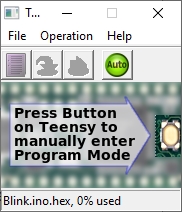 Teensyduino is the name of the PJRC software that adds features and libraries that support the Teensy boards on the Arduino IDE. Support is available for Windows, Mac OS X and Linux.
Teensyduino is the name of the PJRC software that adds features and libraries that support the Teensy boards on the Arduino IDE. Support is available for Windows, Mac OS X and Linux.
The download and installation instructions can be found at: https://www.pjrc.com/teensy/td_download.html
When Teensyduino is running which it should do automatically, a small window is opened on the desktop. This is the Teensy Loader application that handles the actual download to the Teensy board. Most of the time you can ignore this window as it defaults to Auto Mode which means it will take care of automatically downloading to the Teensy without needing to press the Teensy Program button, but it does need to be running in order to download to the Teensy boards.
Once you have the software installed, running the venerable ‘Blink’ program that blinks the on-board LED every second is no harder than a typical Arduino.
The Teensy 4.1 has the on-board LED attached to pin 13 like a typical Arduino.
If the setup is correct, the software will compile and download to the Teensy. The onboard LED should start blinking once per second. Since the board will already have Blink installed when you receive it, you might want to change the timing of the blink to verify the new download was successful.
The Teensy 4.1 operates at 3.3V internally and expects I/O to not exceed 3.3V. It is not 5V tolerant on any of its pins except for the VIN and VSUB pins which can be used to supply 5V power to the module.
If you use any 5V peripherals that drive signals back to the Teensy 4.1, be sure to utilize logic level shifters to avoid possible damage.
If you need a Teensy in a similar package that is 5V tolerant, the Teensy 3.5 may be a good choice to consider.
The Teensy 4.1 can be powered one of 3 different ways, but it is important to note that these are mutually exclusive unlike typical Arduino boards. Internally the module does not provide any power switching between the different power inputs. In essence, if you hook up two different power inputs such as through the USB cable and also through the VIN pin, those two power sources will be shorted together.
USB power (VUSB) – This is typically 5V supplied through the USB cable. A solder pad next to the USB connector also connects to the same VUSB power. An on-board regulator provides 3.3V to power the module
The Teensy 4.1 can also act as a USB Host and supply 5V power coming in on the VIN power input or VUSB pin and put it out the USB host port.
VIN pin – External power of 3.6V to 5.5V can be applied to the VIN pin which also powers the on-board 3.3V regulator to power the rest of the module.
3.3V pin (x2) – These are normally used as outputs to power 3.3V peripherals. Total current should be limited to less than 250mA to avoid overheating. Also if you draw too much power and cause the 3.3V to dip down around 3.0V, the CPU will reboot.
External power of 3.3V can also be applied to the 3.3V pins to power the Teensy in some cases, but this bypasses the on-board regulator which properly handles the power up sequence. This option is not recommended without doing some research. Specifically, VBAT needs a 3V power source such as a coin cell before applying power to the 3.3V pins.
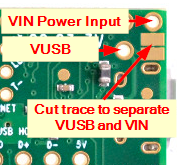 Avoiding Power Problems
Avoiding Power Problems
The most likely way to run into trouble with power is by having the Teensy normally powered through VIN and then deciding to hookup the USB cable to download new code without disconnecting VIN first.
If it is desired to separate the VSUB and VIN power inputs, there is a trace between two large solder pads that can be cut as shown here. If the module is normally powered through VIN, this prevents the USB power from also connecting to the board.
A USB cable can also be modified by cutting the red 5V power wire inside cable to make it a data only cable.
The USB port on the Teensy 4.1 has significant functionality not available on a normal Arduino. For most standard applications it should be set to the default “Serial” mode which is how it works with an Arduino. If you have problems connecting to the Teensy, check this setting.
A quick scan of the menu options available gives an indication of the flexibility of the USB port on Teensy 4.1.
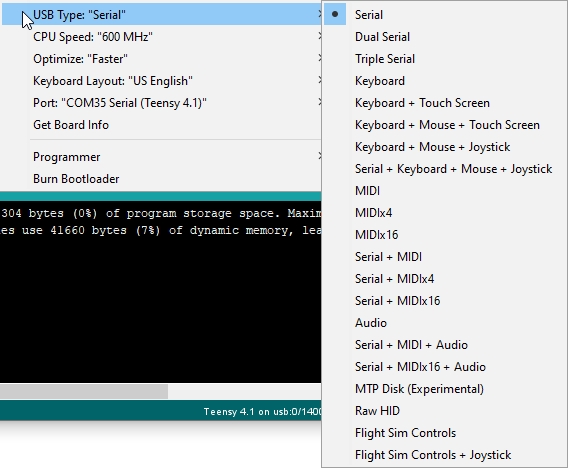
The connector used is the standard Micro-B USB. As with any boards that use this small connector, use care to push/pull the cable directly in and out of the connector and not apply pressure upwards in a lever motion to avoid possible damage.
The button on a Teensy board is not a typical reset button like on an Arduino. When pressed, the program button causes the Teensy to enter ‘Programming Mode” where it waits for a download over USB. If the Teensy is connected to the IDE via a USB cable, the last program will automatically be downloaded again and ran.
If the program button is pressed and held for about 15 seconds, the red LED will flash. When the button is then released, the FLASH memory is fully erased and a known good LED blink program is restored into FLASH memory and starts to run. This is a handy way to help restore an otherwise bricked module due to an errant program.
You didn’t select the Teensy 4.1 because it has a slow CPU, so naturally you are going to notice the CPU speed selection available in the IDE while poking around.
The default speed is 600MHz. You can select a lower speed to operate at, such as 24MHz, mainly for power sensitive applications. On the other hand you can also overclock the CPU potentially all the way up to 1.008GHz if adequate heat sinking is provided. Keep in mind that the parts on the board are graded for 600MHz, so performance at clock speeds above that cannot be guaranteed.
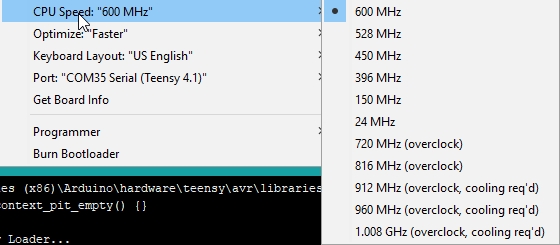
One nice feature is the the CPU has dynamic clock scaling that automatically adjusts timing parameters based on the clock speed that it is running. Recommended that you get up and running at nominal 600MHz before messing with this control.
The Teensy CoreMark benchmark page has some excellent information on performance, current and temperature over different operating frequencies.
There are two 8-pin SMD footprints on the bottom of the module under the SD card slot. The user can add chips to these locations to enhance the functionality or they can buy our preassembled and tested Teensy 4.1 Fully Loaded products near the bottom of the page.
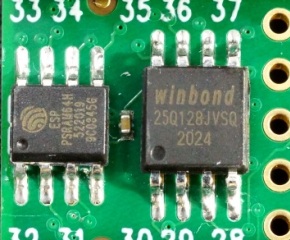
The smaller footprint supports an 8MB PSRAM chip. In addition, PSRAM can also be installed on the 2nd larger footprint providing a total of 16MB (128M-bit) additional memory. If only one PSRAM is being installed, it must be positioned on the smaller pads. PSRAM is handy for adding additional volatile data storage.
Use the extRAM_t4 library to work with PSRAM.
Use this Teensy41_psram_memtest to test the memory chip is properly mounted.
The approved compatible PSRAM chips which are interchangeable include:
The latest price of Teensy 4.1 Development Board in Bangladesh is BDT 9,510 You can buy the Teensy 4.1 Development Board at best price from our RoboticsBD or visit RoboticsBD Office.
|
Please note that the product information provided on our website may not be entirely accurate as it is collected from various sources on the web. While we strive to provide the most up-to-date information possible, we cannot guarantee its accuracy. We recommend that you always read the product labels, warnings, and directions before using any product. |
|
Product Images are shown for illustrative purposes only and may differ from the actual product. |
Reference: RBD-3127
The LILYGO® T-Call A7670E is an advanced ESP32 development board featuring the A7670E LTE/GSM module for cellular network connectivity. This board integrates ESP32-WROVER-E, providing WiFi and Bluetooth capabilities, making it a versatile choice for IoT and embedded applications requiring both wireless and cellular communication.
Reference: RBD-2053
ATMEGA32U4 running in 5V / 16MHz Support Arduino IDE V1.0.1 Micro USB interface programming on the board Four 10-bit ADC pin 12 digital I / O (5 PWM capability) Rx and Tx hardware serial connection. RoboticsBD
Reference: RBD-3175
Brand: ST Microelectronics
The STM32F4DISCOVERY board is an advanced development platform designed to showcase the high-performance capabilities of the STM32F407 microcontroller with its 32-bit ARM Cortex-M4F core. Suitable for both beginners and experienced developers, it provides a complete solution for exploring and implementing powerful applications. The board comes equipped...
Reference: RBD-2417
Compact Replacement: Designed as a modern replacement for the classic Arduino Nano with the same layout and pin configuration. Enhanced Performance: Features the powerful ATMega4808 microcontroller with larger RAM (6KB) and FLASH memory (48KB). Plug-and-Play USB: Integrated ATSAMD11D14A USB converter for seamless driver-free setup on most operating...
Reference: RBD-0032
USB Driver: CH340 Operating Voltage (logic level): 5V With Mini USB 8 analog inputs ports: A0 ~ A7 14 Digital input / output ports: TX, RX, D2 ~ D13 1 pair of TTL level serial transceiver ports RX / TX Using Atmel Atmega328P-AU MCU There is a bootloader installed in it Standard 0.1” spacing DIP (breadboard friendly). Manual reset switch. Please select...
Reference: RBD-3433
The STM32F103C6T6 Type-C Imported Blue Pill Board is a high-performance microcontroller development board, featuring the original STMicroelectronics STM32F103C6T6 chipset. With its ARM Cortex-M3 processor, 72MHz clock speed, and 64KB Flash memory, this board is perfect for IoT applications, robotics, automation, and embedded systems development.
Reference: RBD-3612
Brand: Seeed Studio
The Seeed Studio XIAO ESP32-C3 is a powerful and ultra-compact microcontroller board built around the 32-bit RISC-V-based ESP32-C3 SoC. It offers robust wireless connectivity via 2.4GHz Wi-Fi and Bluetooth 5.0, making it an excellent solution for IoT, smart home, and wearable device applications. With support for Arduino and CircuitPython, deep sleep...
Reference: RBD-2789
The ESP32-S3 WROOM Development Kit 2 is a comprehensive development solution based on the ESP32-S3-WROOM-1 module, featuring an onboard PCB antenna and advanced peripherals. This kit comes bundled with an OV2640 camera, providing a complete hardware platform for prototyping and developing IoT, AI, and wireless communication applications.
Reference: RBD-3592
Built-in Flash: 32Mbit Power supply: 5V WiFi protocol: IEEE 802.11 b/g/n Peripheral interface: UART/GPIO/ADC/DAC/SDIO/PWM/I2C/I2S Logic level: 3.3V A high-quality USB cable is essential for this board to ensure sufficient current supply; otherwise, your board may not be recognized by the Windows Device Manager. Please avoid using mobile phone cables and...
Reference: RBD-1215
131 powerful instructions – Most Single Clock Cycle Execution 32 x 8 general purpose working registers Fully static operation Up to 20MIPS throughput at 20MHz On-chip 2-cycle multiplier Write/erase cycles: 10,000 flash/100,000 EEPROM Optional boot code section with independent lock bits In system programming by on-chip boot program True read while write...
Reference: RBD-3170
Brand: ST Microelectronics
STM32F411E-Disco Development Kit - Discovery Board with STM32F411VET6 Cortex-M4F Microcontroller The STM32F411E-Disco Discovery Kit is a comprehensive development platform featuring the STM32F411VET6 microcontroller. Powered by the advanced ARM Cortex-M4F core with a hardware floating-point unit, this kit provides developers with a robust tool to explore...
Reference: RBD-2944
Brand: Arduino Official
Manufacturer: Arduino Officials Micro-controller : ATmega328P. Operating Voltage: 5V. Input Voltage (recommended) : 7-12V. Digital I/O Pins: 14 (of which 6 provide PWM output). Analog Input Pins: 6.Imported from DFrobot (04-June-2025)Made in ItalyArduino SKU: A000066
Reference: RBD-2196
USB Type: Type-A to Type-B Weight: 26 gm. Length: 50 cm Long cable for easy work Fully compatible with the PC. Molded strain relief and PVC over-molding to ensure a lifetime of error-free data transmissions.
Reference: RBD-0155
Microcontroller: ATmega328 Circuit Operating Voltage: 5V Clock frequency: 16MHz. Digital I/O Pins: 14 8 analog input port: A0 ~ A7. A pair of TTL level serial port transceiver : RX / TX. 6 PWM port: D3, D5, D6, D9, D10, D11. Support serial download.
Reference: RBD-1523
Microcontroller: ATmega328P Circuit Operating Voltage: 5V Clock frequency: 16MHz. 6 PWM port: D3, D5, D6, D9, D10, D11. Use For Atmel Atmega328P-AU microcontroller. Support serial download. Support 9V battery. A pair of TTL level serial port transceiver : RX / TX.
Reference: RBD-2371
Powered by TSMC's 40nm technology for reliable and power-efficient performance. Supports multiple I/O connections with 2.54mm pin headers for easy peripheral integration. Equipped with CP2102-GM USB to Serial chip for smooth programming and debugging. Compact, durable design with versatile applications in IoT, automation, and robotics.
Reference: RBD-1218
Model No.:NX8048T050 Display Type:011R(R:Resitive Touchscreen) Operating Voltage (VDC):4.75 ~ 7 Max. Operating Current (mA):410 Touch Type: Resistive Colors:65K (65536)
Reference: RBD-2309
ESP8285 ESP-M2 Development Board with built-in 1MB FLASH memory Features the reliable ESP8266 processor with full WiFi functionality Pre-programmed with NodeMCU Lua firmware for quick project setup Compact, solder-friendly design with onboard PCB antenna Ideal for smart home automation, IoT projects, and sensor networks
Reference: RBD-3609
Brand: Seeed Studio
The Seeed Studio XIAO ESP32-C6 is a thumb-sized, feature-rich microcontroller board built around Espressif’s powerful ESP32-C6 chip. Designed for next-generation IoT applications, it delivers robust multi-protocol wireless connectivity including Wi-Fi 6, Bluetooth 5 LE, Zigbee, and Thread—all within a compact 21 x 17.8mm form factor. With support for the...
Reference: RBD-0094
The Arduino Uno R3 High-Quality Edition Arduino UNO in Bangladesh Micro-controller : ATmega328. Operating Voltage : 5V. Input Voltage (recommended) : 7-12V. Digital I/O Pins : 14 (of which 6 provide PWM output). Analog Input Pins : 6. The Arduino Uno R3 High-Quality Edition embodies superior craftsmanship and meticulous attention to detail, resulting in...
Reference: RBD-2651
D1 Mini board with 4 MB flash memory and ESP8266 chipset. The board can be programmed with Arduino IDE, has the CH340 USB chipset and allows you to create IoT devices quickly and easily.
Reference: RBD-3130
The WeAct STM32H723VGT6 Core Board is a high-performance development platform designed around the STM32H723 microcontroller, part of the STM32H7 series. With a powerful ARM Cortex-M7 core running at up to 550MHz, it is ideal for advanced embedded projects requiring robust processing, graphics, and data handling. This board includes features such as a TFT...
Reference: RBD-2137
ESP32 Development Board Integrated antenna and RF balun Dual-mode Wi-Fi and Bluetooth chips Small size and high performance-price ratio Compatible with Arduino
Reference: RBD-2490
Support TCP/IP protocol: TCP, UDP, ICMP, IPv4 ARP, IGMP, PPPoE and Ethernet Built-in 10BaseT/100BaseTX Ethernet physical layer Support automatic communication handshaking(full duplex and half duplex), Support automatic MDI/MDIX, automatically revise signal polarity Support ADSL connection (support PAP/CHAP certification mode in PPPoE protocol), Support...
Reference: RBD-2268
Features WiFi+Bluetooth connectivity with the ESP-WROOM-32 module Accessible I/O pins via extension headers for easy customization Onboard USB CH340 for convenient programming and debugging 2x keys for reset or user-defined functions ESP32S-DEV development board is a cost-effective solution for a wide range of applications.A high-quality USB cable is...
Reference: RBD-3424
The Arduino Uno R3 Green Board Edition Micro-controller : ATmega328. Operating Voltage : 5V. Input Voltage (recommended) : 7-12V. Digital I/O Pins : 14 (of which 6 provide PWM output). Analog Input Pins : 6. This Arduino Uno R3 was sourced from an unofficial supplier and is therefore marked as an unofficial version. If you need the official Arduino Uno...
Reference: RBD-3169
Brand: ST Microelectronics
The STM32F051 Discovery Development Kit is designed to provide an easy and efficient way to explore and develop projects with the STM32F051R8T6 microcontroller. Powered by the ARM Cortex-M0 core, this development board offers a rich feature set, including debugging capabilities, user-friendly interfaces, and onboard peripherals, making it ideal for both...
Reference: RBD-1603
USB-TTL converter. Logic Level: 5V. Operating Supply Voltage: 5V. Digital I/O Pins: 14. Analog I/O Pins: 6.
Reference: RBD-1875
Fully compatible with the PC. Moulded strain relief and PVC over moulding to ensure a lifetime of error-free data transmissions. Aluminium under mould shield helps meet FCC requirements on KMI/RFI interference. Foil and braid shield complies with fully rated cable specifications reducing EMI/FRI interference.
Reference: RBD-3589
Power input: 4.5V ~ 9V (10VMAX), USB-powered Transfer rate: 110-460800bps Support UART / GPIO data communication interface Support Smart Link Smart Networking Working temperature: -40°C ~ + 125°C Drive Type: Dual high-power H-bridge Don’t need to download resetting A great set of tools to develop ESP8266 Flash size: 4MByte Lowest cost WI-FI Note: The...
Reference: RBD-2573
A slip ring is an electromechanical device that allows the transmission of power and electrical signals from a stationary to a rotating structure. A slip ring can be used in any electromechanical system that requires rotation while transmitting power or signals. It can improve mechanical performance, simplify system operation and eliminate damage-prone...
Reference: RBD-2616
We understand that soldering can be a daunting task, especially for those who are new to it. That's why we're pleased to offer our expert soldering services to ensure your newly purchased modules are assembled flawlessly. আমাদের বেশিরভাগ মডিউলকে কাজ করার পূর্বে পিনহেডার সোল্ডারিং করা লাগে। কিন্তু অনেক সময় দেখা যায় যারা নতুন তারা সঠিকভাবে সোল্ডারিং করতে...
Reference: RBD-2106
40P color jumper wires Length: 300mm Weight: 45 gm Compatible with 2.54mm spacing pin headers High quality and in good working condition Durable and reusable Easy to install and use
Reference: RBD-2104
40P color jumper wires Length: 300mm Weight: 45 gm Compatible with 2.54mm spacing pin headers High quality and in good working condition Durable and reusable Easy to install and use
Reference: RBD-0133
830 Solder-less Points Ideal for Experimenting With Circuit Design In Labs Compatible with resistance, diodes, transistors, LED’s, Capacitors and other types of electronic components Colored coordinates for easy components placement. Accept a variety of wire sizes 20-29 AWG
Reference: RBD-0394
They are very useful for connecting components to wires. It is insulation covered clips connected to the wire from both ends. RoboticsBD
Reference: RBD-2105
40P color jumper wires Length: 300mm Weight: 45 gm Compatible with 2.54mm spacing pin headers High quality and in good working condition Durable and reusable Easy to install and use
Reference: RBD-0364
Reduces the risk of hardware failure due to overheating Low profile, will fit into most cases. Simple, Passive cooling. No need for noisy fans. RoboticsBD Perfectly sized for the RPi’s CPU